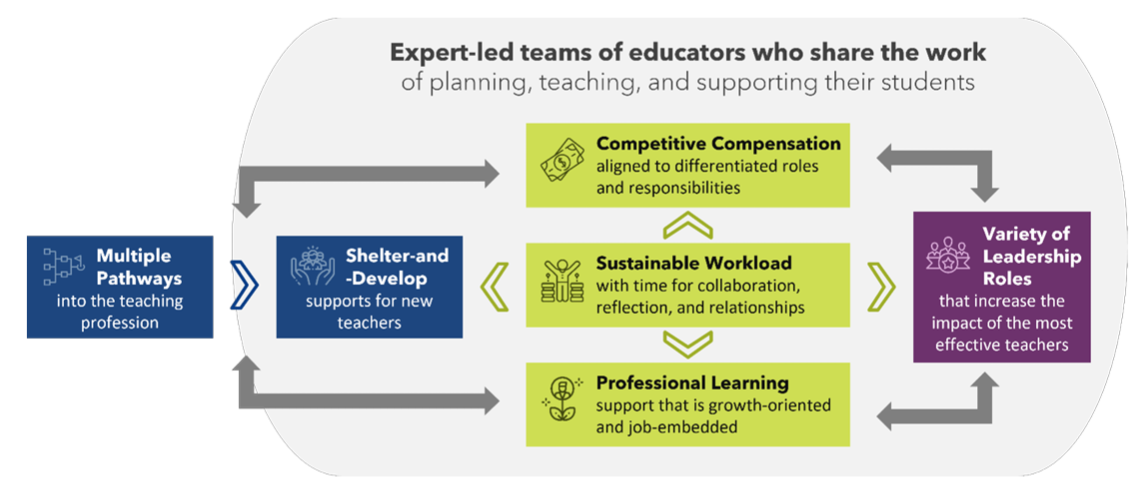Building the capacity of state and district leaders and other stakeholders is vital to the long-term success of reimagining teaching roles. Education Resource Strategies, a national nonprofit, identifies four key areas of impact as being vital to effectively reimagining the teaching role: leveraging teams, expanding on-ramps, improving the core job, and deepening impact.
Reimagining Teaching Roles in Practice

ERS aims to drive change through leveraging teams (grey), expanding on-ramps (blue), improving the core job (green), and deepening impact (purple). These strategies are discussed in-depth below.
Source: Education Resource Strategies
Leveraging Teams: ERS emphasizes a team-based approach, believing that students are more likely to see results from a diverse group of educators with different strengths. This approach allows teachers to lean into their expertise and frees them from trying to be everything to all students. Instead, teams are built that leverage individual skills and expertise to provide more effective instruction. ERS notes that in an ideal environment, educator teams share responsibility for planning, teaching, responding to student needs, and ultimately achieving student outcomes.
Expanding On-Ramps: Many aspiring educators face hurdles like limited access to high-quality preparation programs and financial burdens that may hinder their ability to pursue the teaching profession. Rather than continuing to rely on historical approaches, such as requiring candidates to complete a teacher preparation program in a traditional college environment, ERS advocates for multiple high-quality pathways that provide “hands-on experience,” like grow-your-own models and expanded residencies. Once in the classroom, these teachers should be “sheltered and developed” with strategies like reduced workloads, fewer teaching hours, and other measures that give newer teachers time to acclimate, observe and be observed, and ultimately hone their craft.
Improving the Core Job: ERS believes that attempts to reimagine what teaching looks like that do not explicitly address core components of the job that lead to dissatisfaction, like unsustainable workloads, subpar compensation, and lack of ongoing support, will be unsuccessful. ERS’s framework emphasizes differentiated team-structures and workloads, whereby teachers hold various levels of responsibility (and are therefore compensated dynamically), believing such an approach reduces a teacher’s overall workload. ERS also emphasizes ongoing professional development through regular classroom observations with targeted feedback and coaching, along with collaborative learning sessions for at least 90 minutes a week. Finally, ERS advocates for moving away from traditional salary structures and toward a model that compensates teachers based on their effectiveness, leadership responsibilities, subject-area expertise, and location.
Deepening Impact: Core to ERS’s approach are robust, fairly-compensated leadership opportunities for educators to grow their impact and careers that do not require them to leave the classroom altogether. ERS posits that these instructional leadership positions, which may include hybrid teaching/coach roles or other teacher leader roles, will increase teacher satisfaction, sense of empowerment, and retention.
